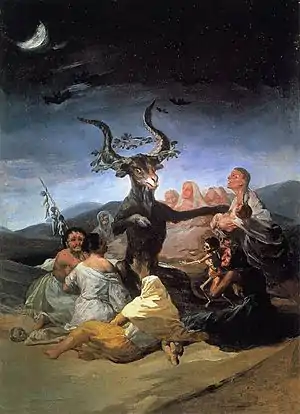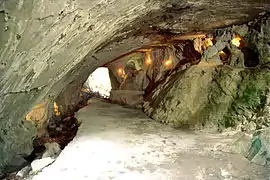Basque witch trials
The Basque witch trials of the 17th century represents the last serious attempt at rooting out witchcraft from Navarre by the Spanish Inquisition, after a series of episodes erupting during all the 16th century following the end of main military operations in the conquest of Iberian Navarre, until 1524. The trial of the Basque witches began in January 1609 at Logroño, near Navarre, bordering on Basque territory.

It was influenced by the background of similar persecutions conducted in bordering Labourd, French Basque Country, by Pierre de Lancre. Although the number executed were small by European standards, it was almost certainly the biggest single event of its kind in history in terms of people investigated. By the end some 7,000 cases had been examined by the Inquisition.
Process
Although Logroño is not a Basque city, it was the setting for an Inquisition tribunal responsible for the Kingdom of Navarre, Alava, Gipuzkoa, Biscay, La Rioja and the North of Burgos and Soria.[1] Among the accused were not only women (although they predominated) but also children and men, including priests guilty of healing with nóminas,[1] amulets with names of saints.[2] The first phase ended in 1610, with a declaration of auto-da-fé against thirty-one of the accused, five or six of whom were burned to death and five of them symbolically, as they had died before auto-da-fé.
Thereafter proceedings were suspended until the inquisitors had a chance to gather further evidence on what they believed to be a widespread witch cult in the Basque region. Alonso Salazar Frias, the junior inquisitor and a lawyer by training, was delegated to examine the matter at length. Armed with an Edict of Grace, promising pardon to all those who voluntarily reported themselves and denounced their accomplices, he traveled across the countryside during the year 1611, mainly in the vicinity of Zugarramurdi, near what is now the French-Spanish border, where a cave and a water stream (Olabidea or Infernuko erreka, "Hell's stream") were said to be the meeting place of the witches.
As was usual in cases of this kind, denunciations flowed in. Frías finally returned to Logroño with "confessions" from close on 2,000 people, 1,384 of whom were children between the ages of seven and fourteen, implicating a further 5,000 named individuals.[3] Most of 1,802 people[4] retracted their statements before Salazar, attributing their confessions to torture. The evidence gathered covered 11,000 pages in all. Only six people out of 1,802 maintained their confessions and claimed to have returned to sabbaths.
In the stir of the events, proceedings were started in Hondarribia too (1611), some 35 km away from Zugarramurdi and 19 km from St-Jean-de-Luz, main hotspots of witchcraft allegations, against presumable female witches accused of casting spells on living creatures and meeting in Jaizkibel in akelarres, led by a he-goat shaped Devil. Men in this Bidasoa region were recruited in droves for Basque whaling, leaving women on their own (sometimes save for the priests, children, and elders) to deal with their problems and fend for themselves during long periods. According to evidence given by a witness as attested in the document, "the Devil summoned in the Gascon language those from San Sebastián and Pasaia, and in Basque those from Irun and Hendaye, addressing a few words to them."[5]
Skepticism
Belief in witches was actually quite low in Spain. It was never strong to start with, and became weaker under the Visigothic law, established by the Visigoths during their last century of rule in Spain and preserved by the Christian nations during most of the middle ages. According to said law, belief in supernatural phenomenon of any sort - witches, fortune tellers, oracles... - was a crime and a heresy in itself. The belief in witchcraft had survived, even though watered down, only in the northmost mountain regions of Galicia and the Basque Country.[6]
The Spanish Inquisition was more inclined to persecute Protestants, Conversos (baptized descendants of Jews and Moors), and those who illegally smuggled banned books into Spain. As far back as 1538 the Council of Inquisition had warned judges not to believe all that they read in Malleus Maleficarum, the infamous witch-finding text . In March 1610, Antonio Venegas de Figueroa, the Bishop of Pamplona, sent a letter to the Inquisition in which he claimed that the witch hunt was based "on lies and self-delusion"[7] and that there had been little knowledge of witchcraft in the region before the outset of the trials.
Contrary to the usual picture of the Inquisition, ready to believe all and every confession of wrongdoing, educated Spaniards were usually skeptical of witchcraft and considered it a northern or Protestant superstition. Salazar, the youngest judge in a panel of three, was also skeptical about the whole thing, saying that he had found no substantive proof of witchcraft on his travels, in spite of the manifold confessions. More than that, he questioned the whole basis of the trials. Because of this disagreement on how to proceed, the matter had to be referred to the Inquisitor-General in Madrid. The senior judges, Alonso Becerra y Holquin and Juan del Valle Alvarado, went so far as to accuse their colleague of being "in league with the Devil." Some of Salazar's objections are remarkable:
The real question is: are we to believe that witchcraft occurred in a given situation simply because of what the witches claim? No: it is clear that the witches are not to be believed, and the judges should not pass sentence on anyone unless the case can be proven with external and objective evidence sufficient to convince everyone who hears it. And who can accept the following: that a person can frequently fly through the air and travel a hundred leagues in an hour; that a woman can get through a space not big enough for a fly; that a person can make himself invisible; that he can be in a river or the open sea and not get wet; or that he can be in bed at the sabbath at the same time;... and that a witch can turn herself into any shape she fancies, be it housefly or raven? Indeed, these claims go beyond all human reason and may even pass the limits permitted by the Devil.
The Inquisitor-General appeared to share his view that confession and accusation on their own were not enough. For some time the central office of the Inquisition had been sceptical about claims of magic and witchcraft, and had only sanctioned the earlier burnings with considerable reluctance, and only because of the reported mood of panic from Logroño. In August 1614 it ruled that all of the trials pending at Logroño should be dismissed. At the same time it issued new and more rigorous rules of evidence, that brought witch-burning in Spain to an end, long before in the Protestant North.[8]
Discussion
The background and circumstances leading to the events unleashed are not unknown to us, if we dismiss the magical and esoteric. In a wider context of religious persecution and conflict in all of Europe, the Catholic Church aimed at suppressing old popular customs and ways, such as hunting witches, that could contend against and question official ideology and manners.
The so-called sabbaths and akelarres may have been meetings out of reach of the official religious and civil authorities. Those who attended the meetings would eat, drink, talk, and dance, sometimes all night long in the forest or caves, at times consuming mind-altering herbs and ointments.[9]
Memory

It was reported that the witches of Zugarramurdi met at the meadow of Akelarre (Basque for "meadow of the he-goat"). Even today aquelarre[10] is the Spanish word for a black sabbath. The village of Zugarramurdi holds the Witchcraft Museum highlighting the appalling events of the early 17th century, where the memory of the victim villagers is dignified.
Akelarre was a 1984 Spanish film by Pedro Olea about these trials. The town of Zugarramurdi now celebrates the witches with a feast by the cave on Midsummer's eve, June 23, the folk date for the summer solstice.
The Basque witch trials are also featured as a subplot in Season 4 of the HBO series True Blood, when the spirit of a powerful witch Antonia Gavilán, fed upon, tortured, and condemned to death by vampire priests in the city of Logroño in 1610, takes possession of a modern-day Wiccan in order to exact revenge on vampires.
References
- General
- Henningsen, Gustav (November 1980). "The Greatest Witch-Trial of All: Navarre, 1609-14". History Today. 30 (11): 36–39.
- Henningsen, Gustav (1980). The Witches' Advocate: Basque Witchcraft and the Spanish Inquisition (1609-1614). Reno: University of Nevada Press. ISBN 0-87417-056-7.
- Inline
- Inquisición at the Auñamendi Encyclopedia.
- Nómina at the Diccionario de la Real Academia Española.
- Erik Midelfort, H. C. (1983). "Vol. 88, No. 3, Jun., 1983". The American Historical Review. 88 (3): 692–693. doi:10.2307/1864648. JSTOR 1864648. PMC 1139208.
- Brujería at the Auñamendi Encyclopedia, by Idoia Estornés Zubizarreta.
- "LOS GASCONES EN GUIPÚZCOA" (in Spanish). IMPRENTA DE LA DIPUTACION DE GUIPUZCOA. Retrieved 2009-04-12.
- Orlandis, José. Historia del reino visigodo español, Madrid, 2003
- The Basque Witch Burnings Archived May 11, 2007, at the Wayback Machine
- Henningsen, Gustav, ed. ‘The Instructions Issued by the Council for Dealing with Witchcraft Cases (Madrid, 29th August 1614)’. In Salazar Documents: Inquisitor Alonso de Salazar Frias and Others on the Basque Witch Persecution, 472–491. Leiden: Koninklijke Brill NV, 2004.
- "Los aquelarres de Zugarramurdi sólo eran "gaupasas" entre vecinos". Diario de Navarra. Archived from the original on 2011-07-24. Retrieved 2009-04-13. Site in Spanish
- Aquelarre in the Diccionario de la Real Academia Española.
External links
- Auñamendi Encyclopedia in Spanish
- María de Echachute, burnt at the stake.
- María de Echalecu, died in prison. Her bones were relaxed to the secular arm".
- Joanes de Echegui, died in prison. His bones were "relaxed to the secular arm".
- María de Echegui, sentenced to confiscation her belongings and life prison. Freed later.
- María de Endara, sentenced to confiscation of her belongings and life prison. Freed later.
- Inesa Gaxen, their belongings were returned and she was indulted. Upon her return to Hondarribia, the local administration did not accept the Inquisition decision; she and her companions were banned to Hendaye.
- Joanes de Goiburu, sentenced to confiscation of his belongings and life prison.
- Miguel Goiburu, died in prison. His image was burnt at the stake.
- Hernando de Golarte, Jesuit. He pleaded for many of the defendants.
- Joanes de Iribarren, sentenced to confiscation of his belongings and life prison.
- Petri de Joangorena, burnt at the stake.
- María de Jureteguia, sentenced to confiscation of her belongings and life prison. Freed later.
- Beltrana de Lafarga, sentenced to confiscation of her belongings and limited prison.
- Joanes de Lambert, sentenced to confiscation of his belongings and limited prison.
- Joanes de Odia, died in prison. His bones were "relaxed to the secular arm".
- Estefanía de Petrisancena, died in prison. Her bones were "relaxed to the secular arm".
- María Presona, sentenced to confiscation of her belongings and life prison.
- Alonso de Salazar y Frías, inquisitor. His reports led to the practical suppression of witch burnings in the Spanish empire one century before the rest of Europe.
- Joanes de Sansin, sentenced to confiscation of her belongings and life prison.
- Domingo de Subildegui, burnt at the stake.
- María de Telechea, sentenced to confiscation of her belongings and life prison. Freed later.
- Graciana Xarra, burnt at the stake.
- María de Zozaya, died from the tortures before the auto-da-fé. Her bones were "relaxed to the secular arm". The article quotes from the confession extracted by Alonso Becerra and Juan del Valle Alvarado.